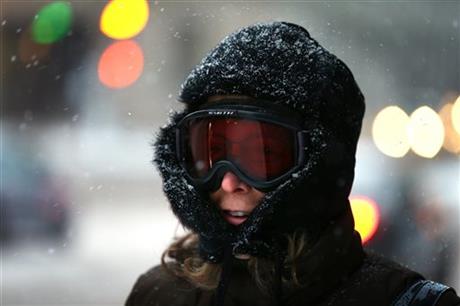
By JAMES NORD
A blast of wintry weather blew into parts of the Rockies and Upper Midwest on Monday, bringing a foot of snow in some areas, along with plunging temperatures. The cold weather is expected to eventually blanket the central U.S. from the Rockies to the Great Lakes region.
The frigid air was pushed in by a powerful storm that hit Alaska with hurricane-force winds over the weekend, and threatened to bury several states in snow and send temperatures as much as 40 degrees below average. A look at the storm and its effects:
BUT IT’S NOT EVEN WINTER YET
By Monday afternoon, areas of northwest Montana saw 14 inches of snow; parts of North Dakota saw as much as 8 inches; a community in central Minnesota got more than 16 inches; northwest Wisconsin communities such as Webster saw 11 inches; and parts of Michigan’s Upper Peninsula had 6 inches, with up to 2 feet expected by the time the storm ends.
Terri Sommerfeld, a clerk at the Webster Ace Hardware, said the store usually sells six or seven snow blowers in a typical winter. That’s how many it’s sold in just two days.
“It hasn’t been overly busy today, but the ones that are coming are buying snow blowers and shovels,” she said.
Winter is still more than a month away, but it may not feel like it. The cold air coming with the snow will be around for a while, said Joe Calderone, a senior forecaster for the National Weather Service.
SNOW: FIREFIGHTER’S BEST FRIEND?
Snow was welcome in northern Wyoming, where firefighters were battling to contain a late wildfire.
Firefighters struggled with the blaze west of Buffalo, and by Sunday evening it had burned almost 2 square miles. Then came the arctic front, with snow and temperatures plunging from the 60s on Sunday to single digits by Monday morning.
“That’s the best fire control you can have is Mother Nature,” said John Garman, a firefighter with Johnson County.
Elsewhere, the weather had the usual effects. In Minnesota, a semitrailer carrying a load of turkeys to a processing plant slipped off Interstate 94 and overturned. In eastern Wisconsin, snow-covered roads were blamed for a school bus crash that sent the driver and an aide to a hospital. No students were hurt, WBAY-TV reported.
The storm stirred anxiety for some farmers in Minnesota and South Dakota whose corn crop had not yet been harvested. The corn can withstand the cold, but deep snow may delay farmers getting it out of fields.
KEEP CALM AND SHOVEL ON
The snow got a mixed reception in Minneapolis, where the first inch tripled morning drive times. At one point, the weather turned to sleet, and tiny pellets stung uncovered faces and hands. Crews were busy plowing, shoveling or brushing off sidewalks, and snowplows did several loops around city streets.
Richard Anderson, who was decorating small trees outside Seven Steakhouse, had a slightly downcast take on the weather.
“As a professional holiday decorator you’d think I’d appreciate it. But I appreciate it when I’m all finished, and I’m finally sitting down and enjoying my own Christmas tree,” he said. “It’s wet, cold, sticks to you. It’s freezing on your jacket as it’s raining. What do you call it? Rain, sleet and snow. And it’s bitter. It’s really bitter. It’s not very nice.”
In Chicago, some people were savoring breezy but mild weather near 60 before freezing temperatures arrive Wednesday.
“I just wanted to enjoy one of the last nice days,” said 44-year-old Joe Kauda, who lives in the Chicago suburb of Carol Stream and works in the mortgage industry.
READY. SET. WAIT.
If you’re flying in the coming days, expect some delays. Minneapolis-St. Paul International Airport estimated roughly one-third of its arrivals and departures would be canceled by the end of Monday.
As far as driving, if you must do it in snow and sleet, be prepared: Have a full tank of gas, an emergency kit and exercise caution. Wind-blown snow can make it difficult to see, and ice underneath can make driving slippery.
“It’s part of being in South Dakota,” said Nancy Miller, a manager at Mid-America Travel Plaza in Belle Fourche. “It’s just the topic of the day. It’s the first snowstorm of the season.”
OMINOUS SIGN?
The wintry blast stirred fears of a repeat of last year’s bitter season, but the National Oceanic and Atmospheric Administration doesn’t expect it. Federal forecasters have predicted this winter will be fairly average.
That doesn’t mean it won’t be cold, and other private weather forecasters are predicting a slightly cooler winter than NOAA.
This week’s storm is part of a powerful system being pushed in by the remnants of Typhoon Nuri that hit Alaska’s sparsely populated Aleutian Islands.
___
Associated Press writers Amy Forliti in Minneapolis and Kerry Lester in Chicago contributed to this report.



